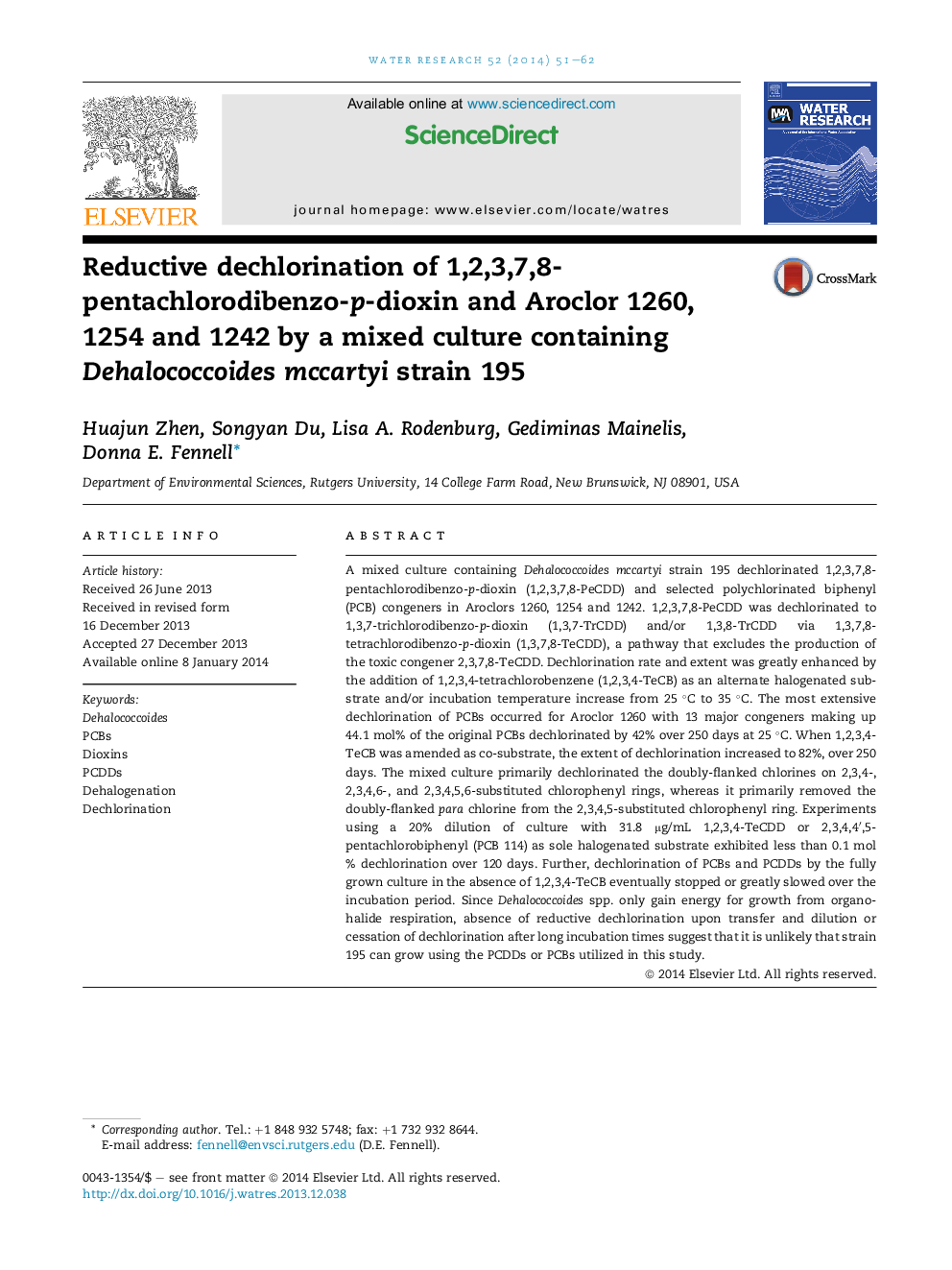| کد مقاله | کد نشریه | سال انتشار | مقاله انگلیسی | نسخه تمام متن |
|---|---|---|---|---|
| 4481662 | 1623116 | 2014 | 12 صفحه PDF | دانلود رایگان |

• We studied dechlorination by a mixed culture with Dehalococcoides mccartyi strain 195.
• The culture dechlorinated and detoxified 1,2,3,7,8-pentachlorodibenzo-p-dioxin.
• The culture dechlorinated PCB congeners in Aroclors 1260, 1254 and 1242.
• Adding 1,2,3,4-tetrachlorobenzene or incubation at 35 °C enhanced dechlorination.
• Dechlorination of PCBs and dioxins does not appear to be linked to growth.
A mixed culture containing Dehalococcoides mccartyi strain 195 dechlorinated 1,2,3,7,8-pentachlorodibenzo-p-dioxin (1,2,3,7,8-PeCDD) and selected polychlorinated biphenyl (PCB) congeners in Aroclors 1260, 1254 and 1242. 1,2,3,7,8-PeCDD was dechlorinated to 1,3,7-trichlorodibenzo-p-dioxin (1,3,7-TrCDD) and/or 1,3,8-TrCDD via 1,3,7,8-tetrachlorodibenzo-p-dioxin (1,3,7,8-TeCDD), a pathway that excludes the production of the toxic congener 2,3,7,8-TeCDD. Dechlorination rate and extent was greatly enhanced by the addition of 1,2,3,4-tetrachlorobenzene (1,2,3,4-TeCB) as an alternate halogenated substrate and/or incubation temperature increase from 25 °C to 35 °C. The most extensive dechlorination of PCBs occurred for Aroclor 1260 with 13 major congeners making up 44.1 mol% of the original PCBs dechlorinated by 42% over 250 days at 25 °C. When 1,2,3,4-TeCB was amended as co-substrate, the extent of dechlorination increased to 82%, over 250 days. The mixed culture primarily dechlorinated the doubly-flanked chlorines on 2,3,4-, 2,3,4,6-, and 2,3,4,5,6-substituted chlorophenyl rings, whereas it primarily removed the doubly-flanked para chlorine from the 2,3,4,5-substituted chlorophenyl ring. Experiments using a 20% dilution of culture with 31.8 μg/mL 1,2,3,4-TeCDD or 2,3,4,4′,5-pentachlorobiphenyl (PCB 114) as sole halogenated substrate exhibited less than 0.1 mol% dechlorination over 120 days. Further, dechlorination of PCBs and PCDDs by the fully grown culture in the absence of 1,2,3,4-TeCB eventually stopped or greatly slowed over the incubation period. Since Dehalococcoides spp. only gain energy for growth from organohalide respiration, absence of reductive dechlorination upon transfer and dilution or cessation of dechlorination after long incubation times suggest that it is unlikely that strain 195 can grow using the PCDDs or PCBs utilized in this study.
Figure optionsDownload high-quality image (160 K)Download as PowerPoint slide
Journal: Water Research - Volume 52, 1 April 2014, Pages 51–62